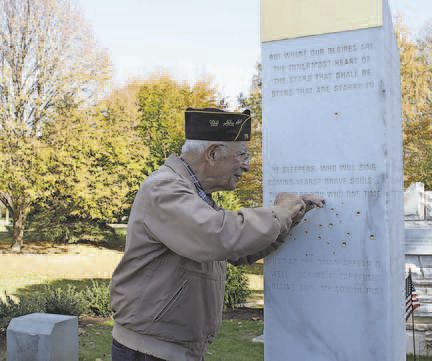By Lea Kahn, Staff Writer
WEST WINDSOR — Surrounded by about 100 veterans and citizens, American Legion Post 76 officials dedicated the post’s American Legion Centennial Memorial — two years before Congress chartered the American Legion in September 1919.
The dedication of the American Legion Centennial Memorial, which is in a grassy field next to the Municipal Building, was the highlight of West Windsor Township’s annual Veterans Day ceremony Nov. 11. The American Legion’s centennial year is 2019.
“We are here to remember the veterans of all wars,” said American Legion Post 76 Commander Bob Cox. American Legion Post 76 was among the first posts chartered in 1919. It was originally chartered in Princeton, but later relocated to West Windsor Township.
Mr. Cox said the idea for a centennial memorial occurred to him while he was watching a documentary on battle monuments and cemeteries. The township has memorials to its veterans, but the centennial memorial commemorates 100 years of service by American Legion Post 76 members in Princeton, West Windsor and neighboring towns.
After discussing the possibility of a centennial memorial with American Legion Post 76 members, Mr. Cox approached Mayor Shing-Fu Hsueh and Township Council. The elected officials supported the idea and within a few weeks, a spot was found for it next to the Municipal Building.
American Legion Post Adjutant Michael McMahon outlined the history of the American Legion. The national organization grew out of a meeting by a group of American World War I veterans in Paris, shortly after the war ended. Congress chartered the American Legion on Sept. 16, 1919, and Post 76 was chartered later that year.
“We thought of the Legionnaires who came before us,” Mr. McMahon said. American Legion Post 76 members were committed to creating the centennial memorial, which honors the national group’s 100th birthday and the 100th anniversary of the end of World War I on Nov. 11, 1918.
Mayor Hsueh said it was “an easy decision to make” when he was approached by Mr. Cox for the American Legion memorial. He said he believes that West Windsor is the first community in the nation to dedicate a centennial memorial to the American Legion.
“As our community gathers in the spirit of unity, let us reflect on Veterans Day. We remember those (military members) who made the ultimate sacrifice, and the families that gave the most treasure — their loved ones,” Mayor Hsueh said.
Sculptor Pietro del Fabro, who designed and created the centennial memorial, was on hand to explain the memorial. The cenotaph is a white marble column at the entrance to the memorial. There is a star field, created by friends and families of deceased veterans and American Legion members, on the cenotaph. There is an introductory poem stone wall.
At the rear of the memorial is a wall made of a mixture of stones — white marble, limestone, granite, blue stone and sandstone, donated by Princeton University. The university’s faculty, staff and students played a role in the founding of American Legion Post 76, including E. A. MacMillan of the Princeton University Class of 1914. He signed the original charter, and was the post’s second commander.
Several relics are embedded on the rear of the wall — among them, Mr. Cox’s dog tag from his service in the United States Air Force, as well as a silver World War II Army Air Force pin give by U.S. Army Col. Gary Brickner in memory of his father, and a minie ball (bullet) from the Battle of Gettysburg.
“It is one of the most fulfilling projects for me. All veterans of all generations supported the project,” Mr. del Fabro said. It has evolved into a history project, as efforts are made to find veterans so a star can be incised in their honor, he said.
Last week at the ceremony, the finishing touches were put to three stars on the cenotaph. Gene Freda inscribed one for his father, Eugene Freda Sr., and Kristin Appelget inscribed one for Mr. MacMillan and Princeton University.
Mr. McMahon inscribed one for Thomas Roy Grover, for whom T.R. Gover Middle School is named. Mr. Grover was killed in action in Vietnam, a few weeks before his tour would have ended. Mr. Grover’s brother, Ted Grover, recalled it in a statement read at the ceremony.
Mr. Grover wrote that he was home on leave, awaiting deployment to Vietnam, when the family learned of Thomas Grover’s death. According to policy, Mr. Grover was not going to be sent to Vietnam because of his brother’s death.
When someone is killed in action, Mr. Grover wrote, it has a “serious” impact of family and friends — not only grief, but guilt. He wrote that he hoped that another star would never have to be engraved on the centennial memorial.
“The veterans memorial should become a place of healing and peace in our community,” he wrote.

